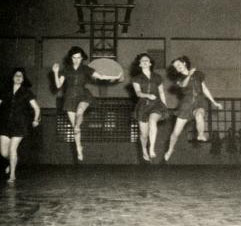 I found this great photo in the 1942 edition of The Quaker, the Guilford College student yearbook. These “nimble-footed coeds” were members of the college Modern Dance Club. It sounds like it was an interesting group. According to the yearbook, “the dancers practiced composing musical pantomimes of their own to a given rhythm, imitating scenes of campus life — a couple enfolded in each others arms, and sitting on a few moaning corpses, typified Guilford’s steady couple having a rendezvous in the graveyard.”
I found this great photo in the 1942 edition of The Quaker, the Guilford College student yearbook. These “nimble-footed coeds” were members of the college Modern Dance Club. It sounds like it was an interesting group. According to the yearbook, “the dancers practiced composing musical pantomimes of their own to a given rhythm, imitating scenes of campus life — a couple enfolded in each others arms, and sitting on a few moaning corpses, typified Guilford’s steady couple having a rendezvous in the graveyard.”
Eighty-eight volumes of The Quaker, the student yearbook of Guilford College, are now available online at DigitalNC.org. The yearbooks, part of the Friends Historical Collection at Guilford, range in date from 1911 to 2005.
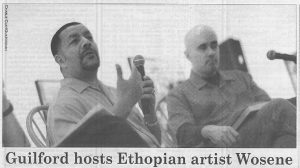
A 2007 article highlighting an exhibition at Guilford College of Ethiopian artist Wosene Worke Kosrof
A new batch of student newspapers have been added to DigitalNC, courtesy of our partner, Guilford College. Included in this collection are nearly 250 issues of The Guilfordian, the student newspaper designed to update, teach, and inform students at Guilford College. Stretching from September of 2005 to May of 2015, this collection represents adding the experiences of nearly 3 generations of college students to our holdings.
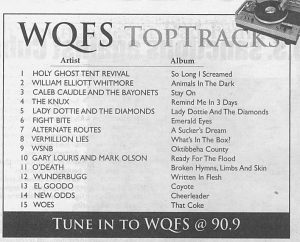
A list of what was being played by student radio station WQFS during the week of April 10, 2009.
The Guilfordian is mostly dedicated to student activity on campus, advertising clubs, events, or speakers coming to Guilford College, it also included other details that students, alumni, or readers may find interesting. For example, as you can see to the left, for several years, the paper included lists of the top tracks played by Guilford College’s own student-run radio station, WQFS 90.9.
While many of the earlier articles are dedicated to student news, news around Greensboro, and activities on campus, readers can see how the direction and editorial stance of the paper changed with each generation of students. Over time, The Guilfordian has developed a stance more towards individual empowerment and highlighting student growth on campus. Just as the paper changed, adding or removing different sections, it is fascinating to see how the student body changed and reacted to different events over the years. For example, as seen below, The Guilfordian covered how Guilford College students demonstrated in Occupy Greensboro in the fall of 2011.

Guilford College students took to the streets in Occupy Greensboro in fall 2011.
To see more issues of The Guilfordian, click here. To learn more from Guilford College, you can see more information by visiting their partner page or taking a look at their website.
Mascots are a complicated phenomenon. They inspire a spectrum of reactions: ridicule, ambivalence, or fierce loyalty. With thousands of yearbooks online, all of us here at the Digital Heritage Center have probably spent more time looking at yearbooks than anyone else you’re likely to meet. Mascots are a common theme.
I’ve been working on today’s post for quite some time; unable to find a history or comprehensive list of mascots in North Carolina I decided to compile one myself. So here’s a stab at a college mascot overview, drawn from yearbooks and other campus publications. Let me know what I’ve missed or gotten wrong!
Children
In the early 20th century, schools frequently chose children as mascots or sponsors, whether for a sports team or for a particular class. The earliest example we’ve found on DigitalNC is from a 1910 publication by Atlantic Christian College (now Barton College) in Wilson, which shows Elizabeth Settle Caldwell as the Senior Class sponsor.
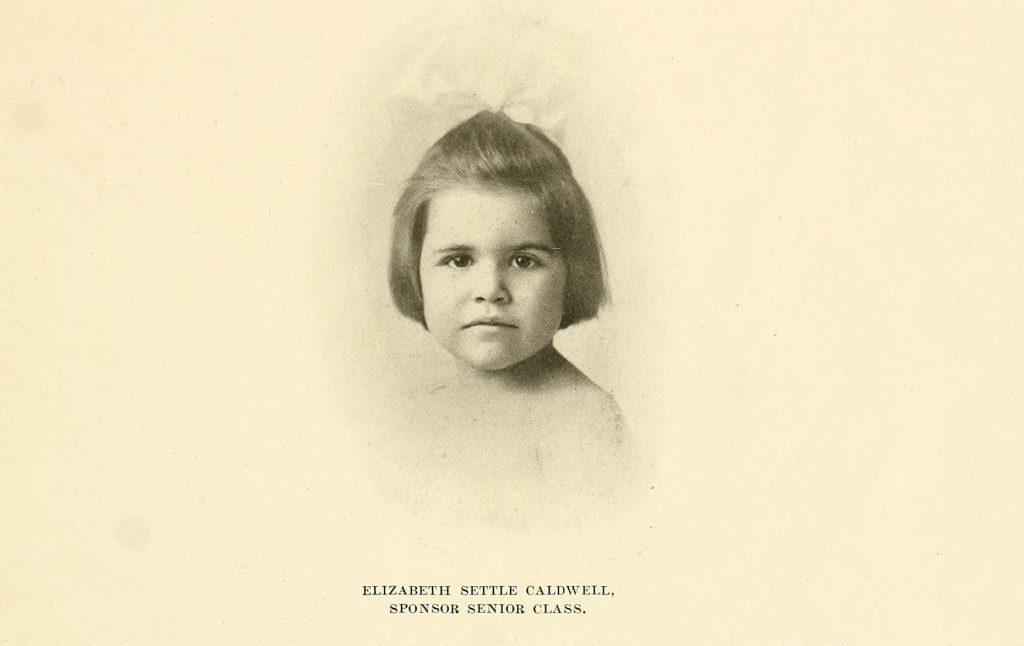
Elizabeth Settle Caldwell, First North Carolina Mascot? From the 1910 Pine Knot yearbook, Atlantic Christian College.
Ms. Caldwell was the daughter of Jesse Cobb Caldwell, the college president. From what we’ve been able to tell, children mascots were frequently younger siblings of students, teachers, or others associated with the school. Students mention that Ms. Caldwell brought “solace to many a lonely, homesick heart” and this may be why children were chosen – to foster a feeling of family and comfort among students. We’ve seen several references to mascots being elected or being chosen through competition, although what this might be we haven’t been able to discover. The trend of choosing children as mascots seems to continue through the 1960s. The latest one we found is Dawn, the Senior Class mascot at Peace College (now William Peace University) in 1966.
Animals
Animal mascots span schools across the state, whether it’s Rameses at UNC-Chapel Hill or WCU’s Catamount. The bulldog and different types of cats win out as most frequently adopted. Pictures of live animal mascots start to appear in yearbooks in the early 1900s, and continue today although much less frequently. For a variety of reasons, including concerns expressed by animal rights activists, schools have shifted away from actual animals to students dressing up like animals, as you’ll see later on in this post.
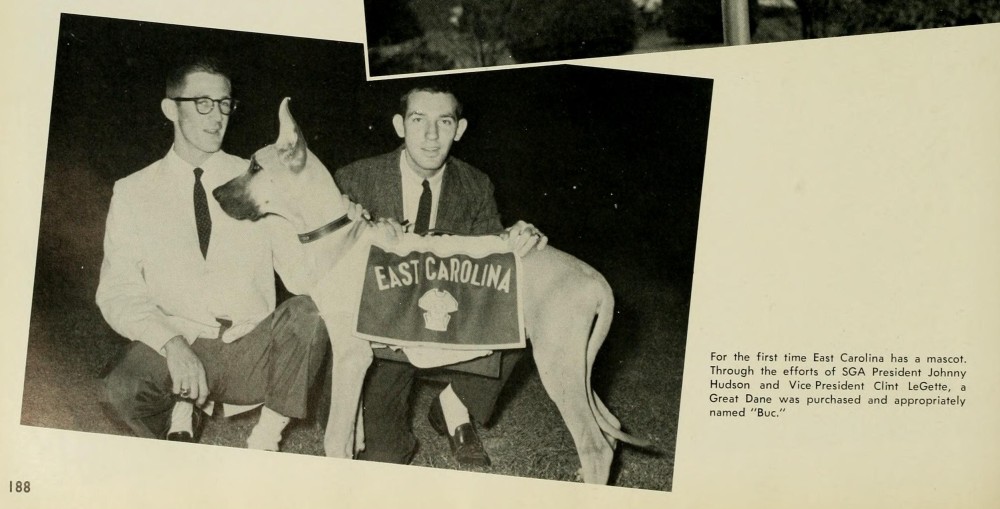
“Buc” is described here as East Carolina University’s first mascot. From the 1959 Buccaneer yearbook.
Characters
While about half of the four-year college mascots in North Carolina are animals, most of the others are characters that are historic, mythical, or extraordinary in nature. From what I’ve seen in NC yearbooks, humans dressing up as the school mascot really got traction in the 1960s. Initially, these costumes weren’t the fuzzy creations we think of today, but rather less complicated ensembles where the mascot’s identity (his or her face and body) was often apparent. Yosef the Mountaineer, beloved icon of Appalachian State University, was created sometime around 1942 and looked like this in the 1960s:
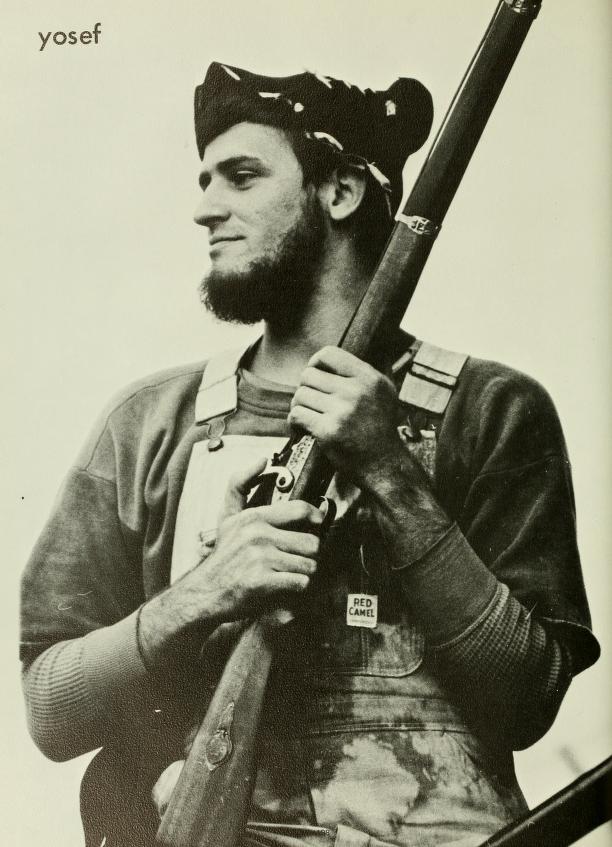
Yosef the Mountaineer, aka James Randle Tedder (we think). From the 1969 Rhododendron yearbook, Appalachian State University.
One of my favorites has to be this picture of Duke Blue Devil, from 1950:
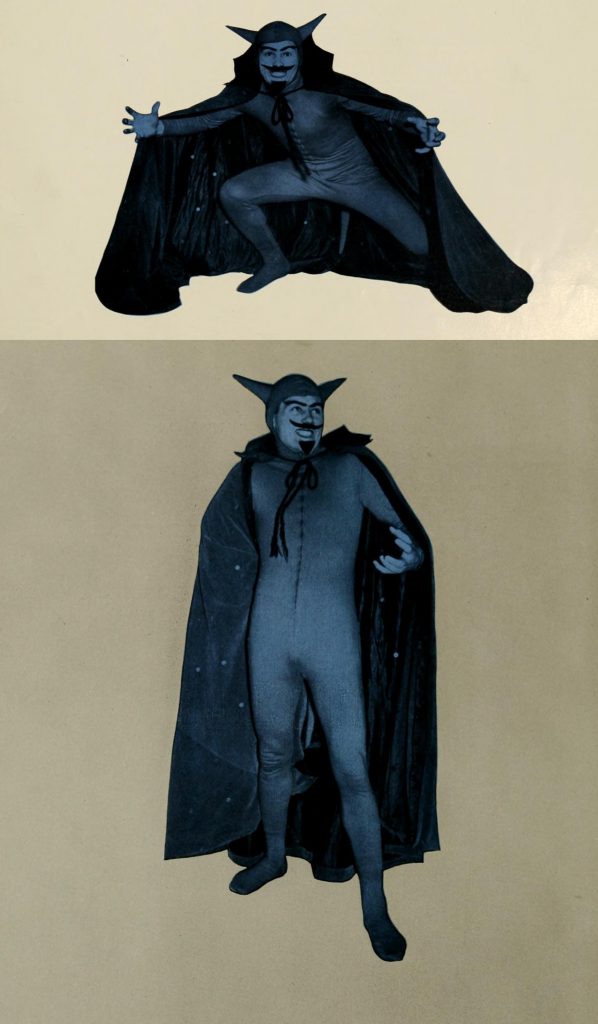
The Blue Devil. From the 1950 Chanticleer yearbook, Duke University.
Perhaps it was too hard to maintain a degree of consistency as students graduated over the years, and mascot anonymity seemed like a better idea. Whatever the reason, you start to see fuzzy, oversized costumes with gigantic headpieces in the late 1970s.
The Big Costumes
Whether animal or character, plush mascots that include a single piece body suit with a large plastic or cloth-covered head is something most Americans can identify with, thanks to professional sports. Colleges in North Carolina really embraced these costumes through the 1980s. Here’s what the UNC-Wilmington Seahawk looked like in 1987:

The Seahawk. From the 1987 Fledgling yearbook, UNC-Wilmington.
Some schools have developed multiple mascots dedicated to different audiences. It seems like the difficulty with these types of costumes is how to pull off a fierce facial expression that doesn’t come off as goofy or too scary for children. I think this picture from Davidson College sums it all up:
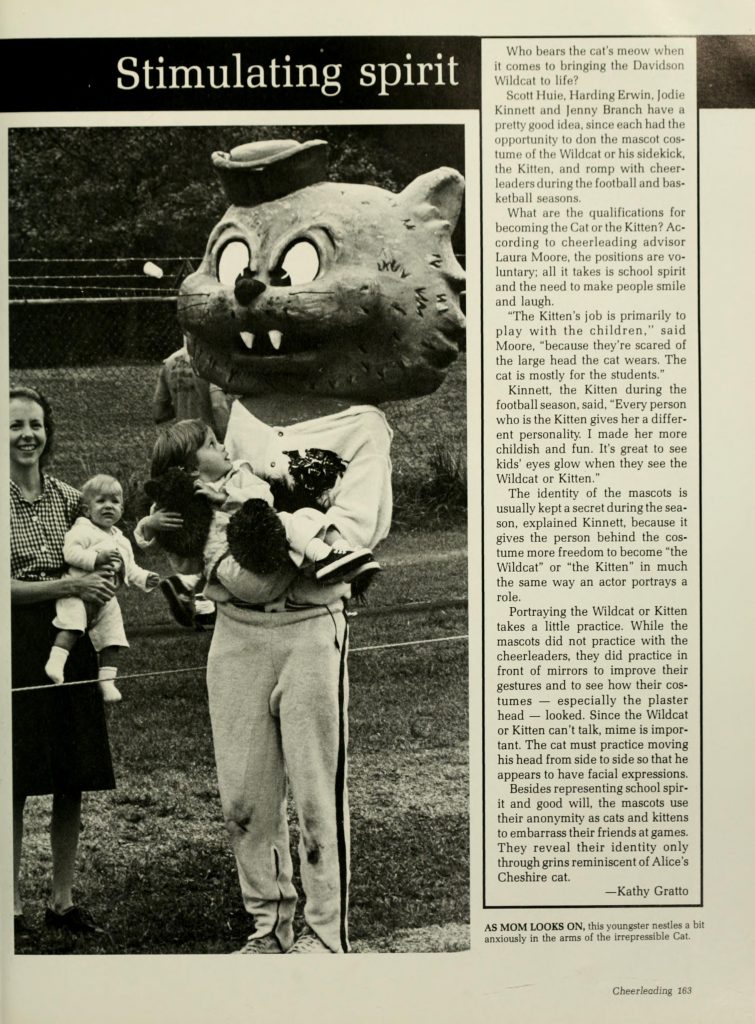
The Davidson Wildcat and … friends. From the 1983 Quips and Cranks yearbook.
I will also take this opportunity to mention a mascot that routinely makes the “wait … what?” list – the Campbell University Fighting Camels:
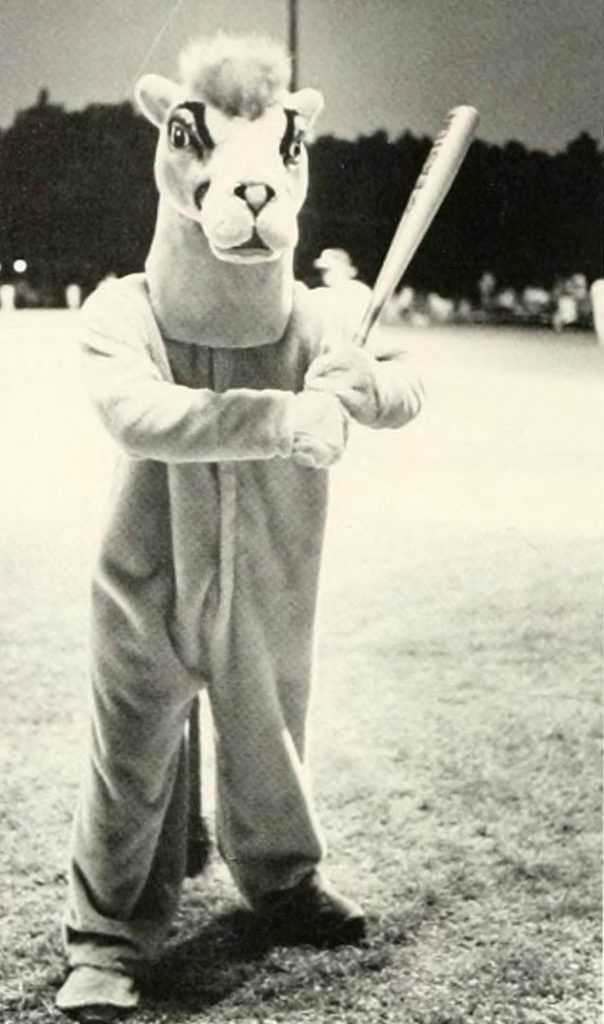
The Campbell Camel. From the 1983 Pine Burr yearbook.
Even the humans and human-like creatures are clothed in oversized costumes these days. Wake Forest University’s Deacon is a dapper chap:
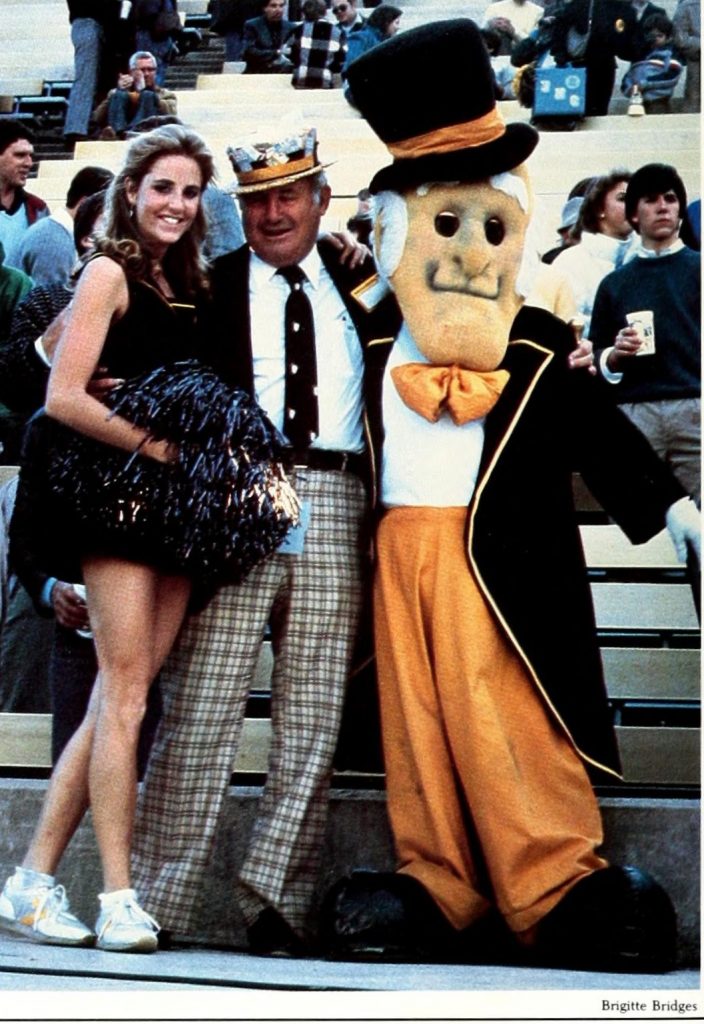
Wake Forest’s Deacon poses with fans. From the 1985 Howler yearbook.
In addition to the Demon Deacons and the Blue Devils, North Carolina boasts a number of other spiritual mascots: North Carolina Wesleyan’s Battling Bishops, Belmont Abbey’s Crusaders, and Guilford College’s Quakers. Meredith College’s teams are known as the Avenging Angels (formerly just the Angels). While Elon University’s mascot is now the Phoenix, before 2000 they were the Fighting Christians:
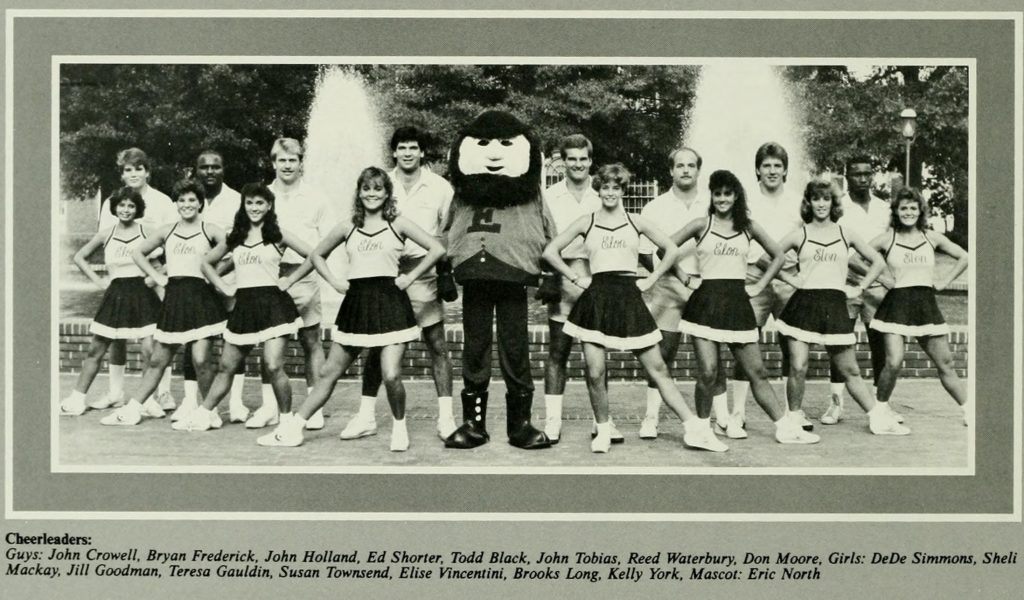
The Elon Fighting Christian mascot with cheerleaders. From the 1986 Phi Psi Cli yearbook.
Two schools break with the animal/human tradition in North Carolina. The Brevard College Tornadoes and the Louisburg College Hurricanes. Weather phenomena mascots are always difficult to pull off. I couldn’t find one for Brevard, but Louisburg, which currently has a bird mascot, had “Louie” up until 2006:
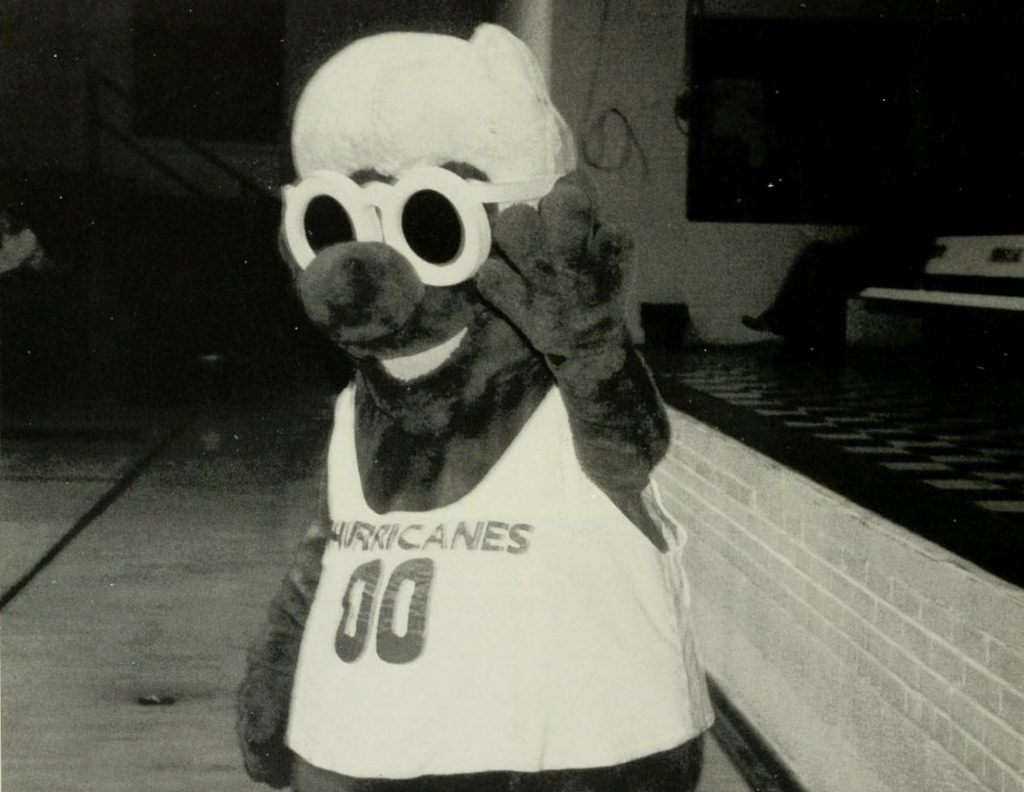
Louie, the former Louisburg College Hurricanes mascot. From the 1996 The Oak yearbook.
Who knows when the next mascot sea change will happen. Below is a list of mascots in North Carolina; let us know if we got anything wrong. Which one is your favorite?
| School |
Mascot |
Notes |
| Appalachian State University |
Yosef the Mountaineer |
First appeared in the yearbook in 1942 |
| Barton College |
Bulldog |
|
| Belmont Abbey College |
Crusader |
|
| Bennett College |
|
Known as the Bennett Belles |
| Brevard College |
Tornado |
|
| Campbell University |
Fighting Camels |
The Hornets in the 1920s-1930s |
| Catawba College |
Catawba Indian |
|
| Chowan University |
Hawks |
The Braves until 2006 |
| Davidson College |
Wildcats |
Also a bulldog (1929) and a bobcat (1939) |
| Duke University |
Blue Devil |
|
| East Carolina University |
Pirates |
Formerly Pee Dee the Pirate |
| Elizabeth City State University |
Vikings |
|
| Elon University |
Phoenix |
The Fightin’ Christians until 2000 |
| Fayetteville State University |
Broncos |
|
| Gardner-Webb University |
Runnin’ Bulldogs |
|
| Greensboro College |
The Pride |
Formerly the Hornets |
| Guilford College |
Quakers |
|
| High Point University |
Panthers |
|
| Johnson C. Smith University |
Golden Bulls |
|
| Lees-McRae College |
Wily the Bobcat |
|
| Lenoir-Rhyne University |
Joe and Josie Bear |
|
| Louisburg College |
Hurricanes |
|
| Mars Hill College |
Mountain Lion |
|
| Meredith College |
Avenging Angels |
Formerly the Angels |
| Methodist University |
Eagles |
|
| Montreat College |
Cavaliers |
|
| Mount Olive College |
Trojans |
|
| North Carolina A&T |
Aggie Dog (Bulldog) |
|
| North Carolina Central University |
Eagles |
|
| North Carolina State University |
Wolfpack |
|
| North Carolina Wesleyan College |
Battling Bishops |
Formerly the Circuit Riders |
| Peace College |
Pacer |
|
| Pfeiffer University |
Falcons |
|
| Queens University of Charlotte |
Rex the Royal |
|
| Saint Augustine’s University |
Mighty Falcons |
|
| Salem College |
Spirits |
|
| Shaw University |
Bears |
|
| St. Andrews University |
Knights |
|
| UNC Asheville |
Bulldog |
|
| UNC Chapel Hill |
Rameses the Ram |
Also known as the Tar Heels |
| UNC Charlotte |
Norm the Niner |
|
| UNC Greensboro |
Spartans |
|
| UNC Pembroke |
Braves |
|
| UNC Wilmington |
Seahawk |
|
| UNC School of the Arts |
Fighting Pickle |
|
| UNC School of Science and Math |
Unicorn |
|
| Wake Forest University |
Demon Deacons |
|
| Warren Wilson College |
Owls |
|
| Western Carolina University |
Catamount |
“Paws” |
| Wingate University |
Bulldog |
|
| Winston-Salem State University |
Ram |
|
April Fool’s Day is upon us. (We thought Google Chrome’s support for emoji translation could be really useful for transcribing some of our newspapers!) These days it seems April Fool’s is mostly played out online, with websites jockeying for the best prank. Taking a look through DigitalNC’s Newspaper Collection shows that pulling pranks on April Fool’s via [print] media is nothing new.
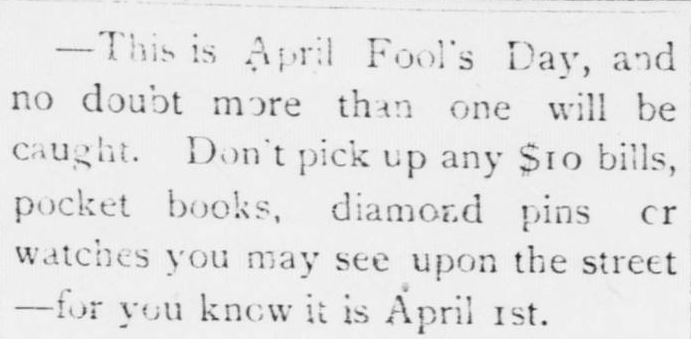
The oldest reference found to April Fool’s Day in the newspapers is from The Wilson Advance in 1897, which reminded its readers which day it was and to be on the alert for pranksters. The small news item gives a glimpse of what April Fool’s jokes entailed in the late 1890s. (for context, $10 in 1897 would equal approximately $268 today)

Starting with the 1937 April Fool’s Day issue of the Clarion from Brevard College, which is the first appearance of an April Fool’s themed paper in NC Newspapers, it appears that special April Fool’s Day editions of student newspapers were popular across North Carolina, as they remain today if you browse through some campus newspapers online. Some of the funnier news headers we found included a color by number of Elon’s Pendlelum in 1999 and the 1991 Goofordian [regularly the Guilfordian] from Guilford College, which also noted that you can read all about the debate over the sweatiest professor on page 2.


To view more newspapers from across North Carolina, visit the North Carolina Newspapers collection and to view specifically more papers from April 1 through the years, check out the “Today in North Carolina History” section on the right side of the page.
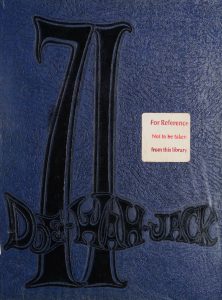
The front cover of the Doe – Wah – Jack yearbook for Walter M. Williams High School in 1971.
Thanks to our partner, Alamance County Public Library, 16 high school yearbooks are now available on Digital NC. Along with the yearbooks, the Burlington Telephone directory is also available. Each yearbook comes from several different high schools in Alamance County during the late 1960s and early 1970s. Yearbook titles include the Doe – Wah – Jack (1971) from Walter M. Williams High School in Burlington and the Aries (1970) from Northeast Guilford High School in McLeansville. These yearbooks join previous years such as the Sylvanian (1960) from Sylvan High School in Snow Camp and the Reg-O-Ala (1959) from E.M. Holt High School in Burlington.
To view our collection of high school and college yearbooks from North Carolina, visit our collection here.
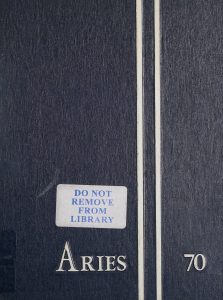
The front cover of Northeast Guilford High School yearbook, Aries in 1970.
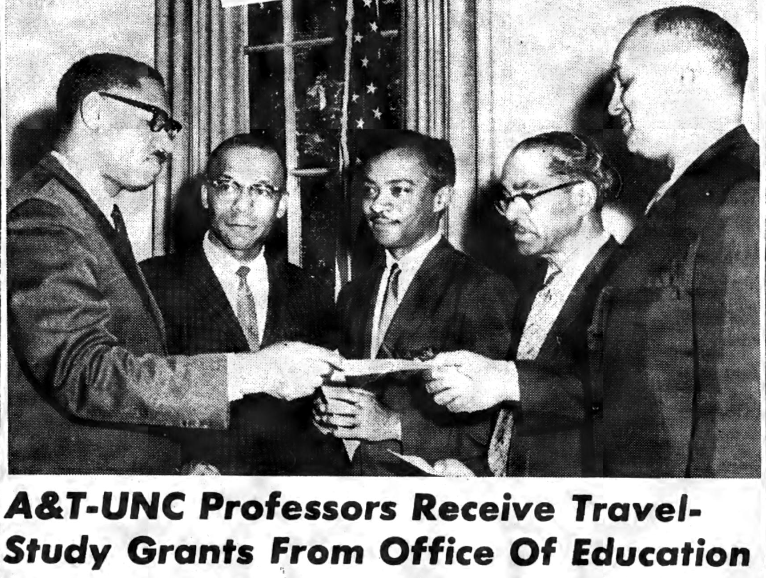
The Future Outlook, July 14, 1967, page 1
The Future Outlook, a community newspaper from Greensboro, NC, is now available on DigitalNC. Thanks to our partner, the University of North Carolina at Greensboro, nearly 25 years of the paper are now online and full-text searchable. The nearly 450 editions range from 1941-1947, 1949, 1952, and 1958-1972.
The Future Outlook served an African American community in Greensboro and documents major events from their perspective. Like community newspapers throughout North Carolina, the paper documented births, deaths, and events of its readership. Economic and business activities received a lot ink over the years, highlighting prominent Black leaders in Guilford County, as well as, members of clubs and professional organizations. Elections and voting related activities are also well documented. Before each election, including smaller city and county elections, the paper published extensive district maps and voting information.
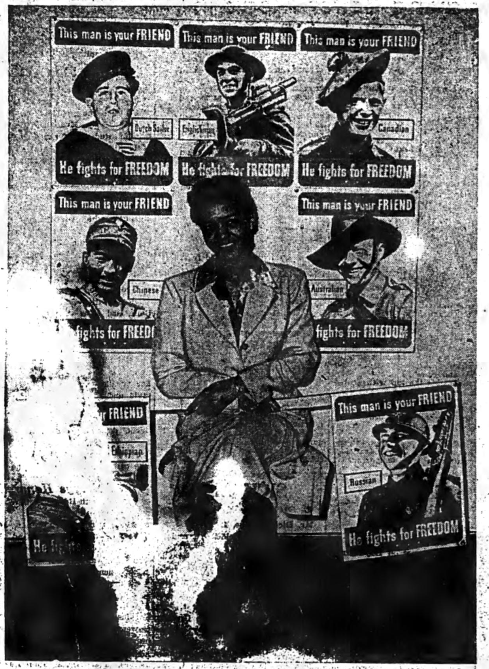
The Future Outlook, June 13, 1942, page 6
Another area that might be of interest for researchers is the paper’s coverage of local educational institutions. Greensboro is home to several historically Black colleges and universities, including North Carolina A&T and Bennett College. Scholars and students at these universities are heavily covered, especially in during the 1960’s. Students on the Dean’s List, scholars who received grants (like the image above), fraternities and sororities, and university conferences cover many front pages and serve as a record of university activities.
Also included in this batch are issues dating from 1941-1947, documenting the entirety of World War II and community reactions to it. Stories, advertisements, and political messages cover the pages during this period. The paper featured stories about locals who were working for the war effort, like Margaret Lanier. Lanier was a secretary in the Press Division of the Office of Facts and Figures. The Future Outlook published the photo on the left of her posing with seven new poster designs to be distributed for Flag Day in June 1942. In addition, there are many of the iconic war advertisements, posters and cartoons, featuring African American men and women.
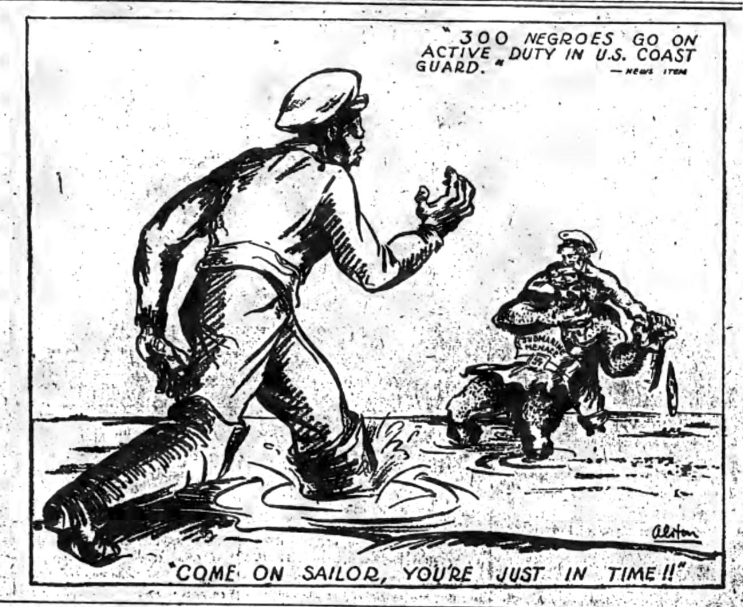
The Future Outlook, September 12, 1942, page 4
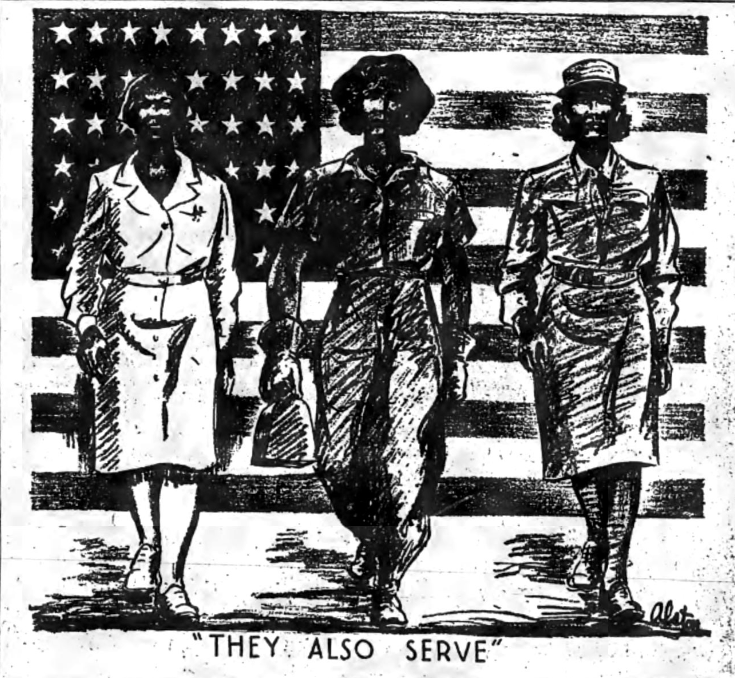
The Future Outlook, September 26, 1942, page 4
To view all of the issues of the Future Outlook, please visit the following link. To view more community newspapers like this one, please visit the North Carolina Newspapers Collection and limit by “Community Papers.” You can also learn more about this partner, the University of North Carolina at Greensboro, by visiting the contributor page or visiting the website.
With the recent addition of student yearbooks from Lees-McRae College, we are very pleased to announce the North Carolina Digital Heritage Center has now worked with 100 different institutions. These 100 content partners have contributed an incredible variety of materials related to the history and culture of North Carolina, all of which is easily and freely accessible at DigitalNC.org.
When we began work on the Digital Heritage Center in late 2009, it was always our goal to reach out to as many different organizations as possible. Here’s the breakdown on types of institutions we’ve worked with so far (some institutions represent multiple types, which is why the numbers add to more than 100):
23 Public Libraries
14 Community Colleges
14 Public Colleges and Universities
32 Private Colleges and Universities
9 Historically Black Colleges and Universities
1 Cultural Heritage Organization
3 Historic Sites
3 Historical Societies
8 Museums
4 Private Libraries and Archives
While we’ve worked with institutions in all parts of the state, we have yet to reach every county. Our partners come from 51 different counties, leaving just under half of the state’s counties yet to be represented. In coming years, we’ll continue to reach out the remaining counties, as well as to organizations of all types and sizes who are interested in working with us on our shared goal of promoting and increasing access to North Carolina’s cultural heritage.
 I found this great photo in the 1942 edition of The Quaker, the Guilford College student yearbook. These “nimble-footed coeds” were members of the college Modern Dance Club. It sounds like it was an interesting group. According to the yearbook, “the dancers practiced composing musical pantomimes of their own to a given rhythm, imitating scenes of campus life — a couple enfolded in each others arms, and sitting on a few moaning corpses, typified Guilford’s steady couple having a rendezvous in the graveyard.”
I found this great photo in the 1942 edition of The Quaker, the Guilford College student yearbook. These “nimble-footed coeds” were members of the college Modern Dance Club. It sounds like it was an interesting group. According to the yearbook, “the dancers practiced composing musical pantomimes of their own to a given rhythm, imitating scenes of campus life — a couple enfolded in each others arms, and sitting on a few moaning corpses, typified Guilford’s steady couple having a rendezvous in the graveyard.”






















